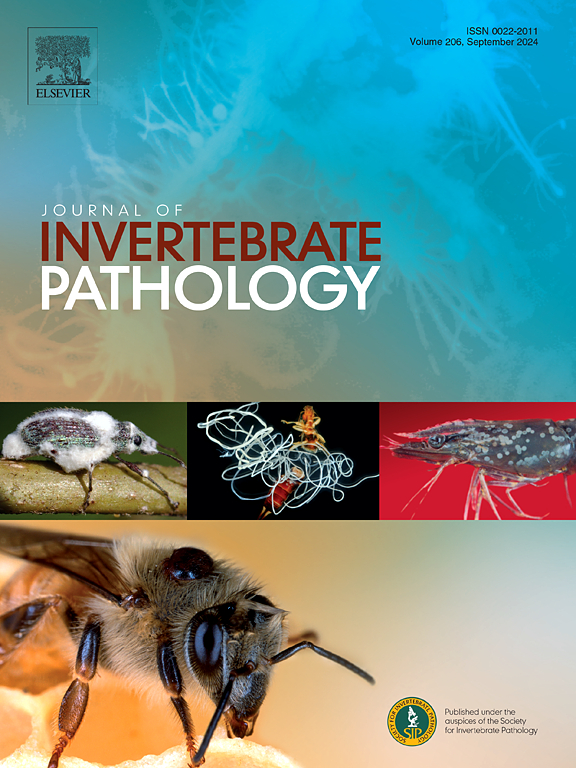Identification and detection of known and new viruses in larvae of laboratory-reared fall armyworm, Spodoptera frugiperda
IF 3.6
3区 生物学
Q1 ZOOLOGY
引用次数: 0
Abstract
The fall armyworm (FAW), Spodoptera frugiperda, is a significant pest that causes economic losses worldwide. Many companies and research centers rear FAW to produce their microbiological-based products, such as viruses that target FAW. Nevertheless, colonies are vulnerable to collapsing, mainly due to uncontrolled and unexpected viral infections. In this work, dead FAWs exhibiting signs of viral infection were collected from unsuccessful attempts to propagate a baculovirus at a baculovirus production facility in Brazil. Total RNA was extracted and used to construct a cDNA library that was sequenced. The results showed the presence of five viruses, including three RNA viruses (alphanodavirus, rhabdovirus, and iflavirus) and two DNA viruses (densovirus and alphabaculovirus). To confirm the presence of the identified viruses in laboratory-reared FAWs, ten individual larvae from four accredited laboratories in Brazil were analyzed by RT-PCR with specific primers for each virus identified by sequencing, except the alphabaculovirus. Alphanodavirus and rhabdovirus were not detected in any of the four tested colonies, whereas the iflavirus was detected in two laboratories. A putative new densovirus was found in all samples. Accurate identification and timely detection of viruses that could disrupt the health of laboratory-reared insect colonies are crucial to ensure the production of high-quality biological products.

实验室饲养秋粘虫幼虫中已知和新病毒的鉴定与检测
秋粘虫(Spodoptera frugiperda)是世界范围内造成经济损失的重要害虫。许多公司和研究中心支持一汽生产他们的微生物产品,比如针对一汽的病毒。然而,蜂群很容易崩溃,主要是由于不受控制和意外的病毒感染。在这项工作中,在巴西的杆状病毒生产设施中,从杆状病毒繁殖失败的尝试中收集了显示病毒感染迹象的死亡FAWs。提取总RNA,构建cDNA文库并测序。结果显示存在5种病毒,包括3种RNA病毒(甲流病毒、横纹肌病毒和黄疸病毒)和2种DNA病毒(致密病毒和甲流病毒)。为了证实实验室饲养的FAWs中存在鉴定出的病毒,采用RT-PCR对巴西4个认可实验室的10只幼虫进行了分析,对测序鉴定出的每种病毒(甲型棒状病毒除外)使用特异性引物进行了分析。在四个测试菌落中均未检测到甲流病毒和横纹肌病毒,而在两个实验室中检测到黄疸病毒。在所有样本中都发现了一种推定的新型致密病毒。准确识别和及时发现可能破坏实验室饲养昆虫群体健康的病毒对于确保生产高质量的生物产品至关重要。
本文章由计算机程序翻译,如有差异,请以英文原文为准。
求助全文
约1分钟内获得全文
求助全文
来源期刊
CiteScore
6.10
自引率
5.90%
发文量
94
审稿时长
1 months
期刊介绍:
The Journal of Invertebrate Pathology presents original research articles and notes on the induction and pathogenesis of diseases of invertebrates, including the suppression of diseases in beneficial species, and the use of diseases in controlling undesirable species. In addition, the journal publishes the results of physiological, morphological, genetic, immunological and ecological studies as related to the etiologic agents of diseases of invertebrates.
The Journal of Invertebrate Pathology is the adopted journal of the Society for Invertebrate Pathology, and is available to SIP members at a special reduced price.

 求助内容:
求助内容: 应助结果提醒方式:
应助结果提醒方式:


